
Propagation is the process of producing new plants by various means and methods. Most will be aware of the seed sowing method of plant propagation, but new plants can also be raised by other methods.
All manner of plants can be propagated to produce new stock. Otherwise, there would be no new plants to carry on the cycle of growth! Plants that you see on the garden centres shelves, have all been propagated by some means or other.
Methods of plant propagation as simple as 'dividing' plants are all classed as propagating. The main aim, is to get extra plants by whatever means suits your own gardening methods

Seed Growing / Planting
Experienced and professional gardeners will use the term 'sowing seeds' when they talk of raising new plants from seed. We rather like the term 'growing seeds' for it immediately reminds us that the seed is actually a plant. An embryo plant maybe, but a plant nevertheless - simply waiting for the right conditions in which to germinate, and subsequently grow.
The term 'growing seeds' makes us a little more aware that the speck of dust is in fact a living thing. A plant in waiting!
As with all living things, the young need special care and nurturing to allow them to develop into healthy 'adults'. Plants are no different. Give them that care they need and they will reward you proportionally by way of a relatively trouble free start to life.

Dicotyledons of peanut
This is not a lesson in plant biology, or a scientific paper. It is simply a brief explanation of what comes out of a seed packet or wherever. To grow plants from seeds, we must have seeds as our raw material, so it would be a good idea to know a little bit about them.
If you do an in-depth study of seeds, you cannot but notice the similarities there are between the method of seed production of plants, and the normal reproduction of animals - humans included. (We do after all share around 60% of our DNA with plants and our DNA is more similar than dissimilar.)
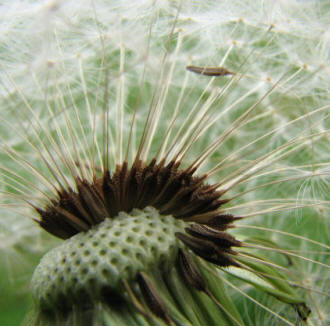
Sowing Seeds Successfully
Get this part of the procedure of growing seeds and you are more likely to succeed than fail. It is in the actual sowing of the seeds that most attempts at seed growing falter or even fail altogether. There is no one method of growing all seeds, for all seeds are different. However there are enough similarities with several groupings to be able to adopt a standard procedure for most seed with variations. Surface sowing seeds.
Seed packets give a wealth of information, but there is nothing that will compensate for care and experience. Many follow what is written on the seed packets yet still fail. As with many things gardening, it is not what is written, but what is not written that leads to success or failure.
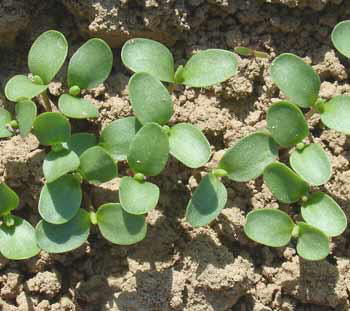
Seed Germination
Germination is the first stage of turning a seed into a plant. Seeds germinate naturally in nature, and provides for the furtherance of the plant population.
Our aim when we sow seeds is for them to germinate and thereafter turn into young plants.
Assuming we give the seeds the correct conditions for growth, the first visible change in the germination process, is that the seed case ruptures or splits, allowing the primary root (the Radical) to emerge - pushing down into the soil to anchor the seed into the ground or compost.
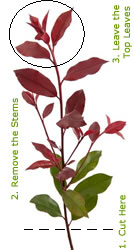
Taking Cuttings
Main page about propagation by taking cuttings. Includes links to pages with all the details about the various types of cuttings that can be taken from plants.
Cuttings can be taken from many plants, but shrubs and perennials (tender and hardy) are the normal choices.
Some plants, you just cannot grow from seed for practical purposes. Take for instance, the very common Forsythia. For various reasons, Forsythias are difficult to grow from seed, but they can easily be grown from cuttings at almost any time of the year. Don't worry, most cuttings are easy; just follow our tips on how to grow cuttings into plants.
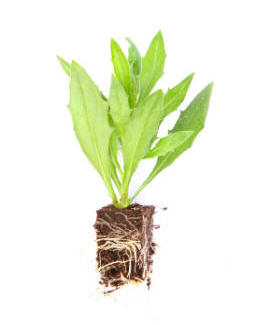
Softwood Cuttings
Taking softwood cuttings from your hardy garden plants is a good way to increase your stock. It is not the easiest method of taking cuttings, but the main advantage is the fact that because softwood cuttings are taken early in the growing season, they have a long time to get established as young plants before the onset of the following winter.
The main period for taking softwood cuttings is spring and early summer - though they can be taken for most of the growing season. Once you master the technique - just a matter of a little bit of care - you will be well on the way to being a provider of plants for friends and plant fairs. Who knows where it will take you? It will certainly broaden your circle of friends!

Semi-Ripe Cuttings
Semi ripe cuttings are taken from garden plants - mainly shrubs, but also perennials - in early summer. They differ from softwood cutting in that they will be longer, and the stem will be more mature after 6 - 8 weeks of new season's growth.
Most of the procedure outlined in taking softwood cuttings should be adhered to.
Semi-ripe cuttings are normally taken from plants during the early to mid summer months. The main difference between them and softwood cuttings being that the stem wood will be more mature and not the soft sappy stem type of the softwood cuttings. They are generally easier to work with than the earlier softwood cuttings.

Hardwood Cuttings
Hardwood cuttings are probably one of the easiest way to propagate new plants, and are normally taken in the least busy time of the garden calendar: Late autumn - early winter. Taking hardwood cuttings is a technique that can be used for many different types of shrubs, but cannot normally be used for other plants.
The cuttings material is taken from shrubs, using the previous last season's ripe growth wood, and simply cutting the leafless stems into segments 6-8in (150 - 200mm) long. It is possible with some shrubs to take 3 or 4 cuttings from one stem.
Simply make your base cut just below an old leaf joint, and cut off the top of the cutting with a slanting cut, (You will then easily be able to recognise the top from the bottom of the cutting - sometimes difficult with some types of shrubs when not in leaf.) The top cut should be just above a leaf joint. It may help rooting if you make a slight wound in the bottom 1in (25mm) of the stem by cutting a sliver of bark away to the wood underneath.

Photinia Red Robin
Photinia Red Robin is an evergreen shrub/tree incleasingly popular, not just as a standalone shrub but it is taking over from the Leylandii as a popular hedgerow. As an evergreen shrub, it does standout with its striking bright red young foliage which is its main feature.
There have been some confusion over its family name, it may be found or listed as "Stranvaesia Red Robin". Photinias are members of the "Rosaceae Family" of trees and shrubs, having the typical small flowers each being made up of 5 typical single rose flowers, but much more smaller.
Fuchsias From Cuttings
Fuchsias are amongst the most popular of summer flowering plants for hanging baskets and containers. There are of course the hardy Fuchsias that flower a little later - often well into the Autumn.
The big plus for Fuchsia propagation is that they can be increased by taking cutting - very easily!
Take cuttings from well-grown young Fuchsia plants, to increase your stock and also to 'pinch out' the growing tip of your Fuchsia.
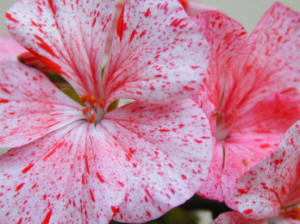
Geraniums - Pelargoniums - from Cuttings
Whilst the propagation of Geraniums (Pelargoniums) is increasingly being done by seed sowing, the traditional way of taking cuttings of Geraniums is a good way of ensuring that you get a supply of plants which are in all ways identical to the parent. Taking Geranium Cuttings is a cost effective way to ensure more plants, though growing geraniums from seed is also an option.
This is not the case with saved seed where the young seedlings are often inferior, and not always true to type. Taking geranium cuttings ensures that your new plant will be the same as the parent.

Dahlia Cuttings
Early Spring is a busy time if you want to increase the number of Dahlia plants that you have.
Dahlias are normally propagated by either soft cuttings, or by division of stored Dahlia Tuber Clumps.
A heated greenhouse is required, to force the Dahlias into growth during late winter - early spring.
Cuttings are normally taken from over-wintered Dahlia Tuber in early spring and placed in a heated propagator for best results. Alternatively a propagating case built onto the greenhouse staging can be used. It should have gentle bottom heat to ensure both compost and inserted cuttings get the necessary heat to promote root growth.
Layering - Propagating by Layers. There are basically two types of layering that are practiced, general layering involves inserting part of a plant into the ground to promote new root growth. The other method of layering is known as air layering, and is used where it is not possible to lower a branch to the ground. It is also useful method of propagation for plants grown indoors - where it is not possible to layer a plant into the ground.
Division - Division is a method of propagating new perennial plants. Easy, mostly foolproof, and suitable for turning an aging perennial into a few - perhaps many - new plants.
Grafting - is a method of inserting a part of a desirable plant into a 'parent' plant in order that the new grafted plant will have many of the characteristics of the 'parent'. Wisterias for instance, are grafted onto a wild wisteria stem, a/ because wisterias are difficult to root from cuttings, b/ because it is a quicker method of producing a saleable plant, and c/ because the wild wisteria seedling plant, will pass on its natural vigour to the new child plant.
Acers / Japanese Maples are grafted because the original root stock will not last our climates, have you ever purchased an Acer from a supermarket and it died? The chances are it was root stock and not grafted. Acers / Japanese Maples specialists supply only grafted trees, which costs more but it will with stand our climates.Budding - Plants can be raised by the propagation technique of budding. This involves removing a 'bud, with little bit of other growth attached, and inserting it beneath the bark of a host plant. Roses in particular are grown using this method. A rose 'cutting' is quite slow to become established, and not always healthy on its own roots. By budding it onto a wild briar-type rootstock, the new rose will have much more vigour than if grown on its own roots. Modern propagation methods now allow some varieties to grow on their own roots - from cuttings.
Stolons and rhizomes. - These are underground stems, roots or 'runners' from which new plants can easily be propagated. Taking the runners of strawberry plants is a method of propagating new plants, that are true to form of their parents.
Micro propagation - Micro propagation is fast becoming a modern technique of propagation plants on a commercial scale. Many plants that used to be difficult to raise in large number, such as orchids, are now propagated from microscopic cell tissue, and spend their early life in a test tube or other sealed container. The success of this type of propagation, has bought down the price of orchids in particular, so that they are now almost an everyday item in many households.